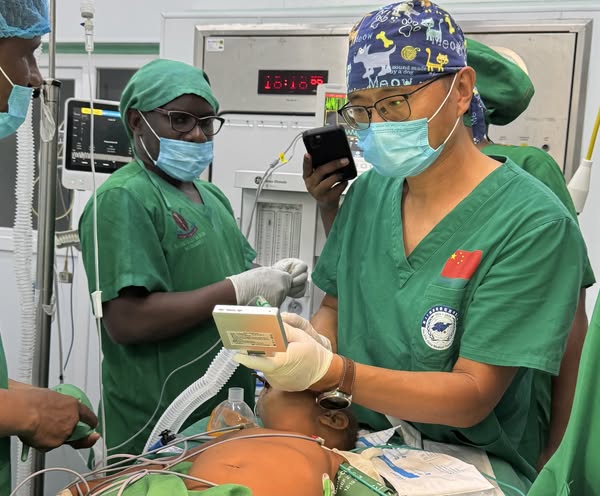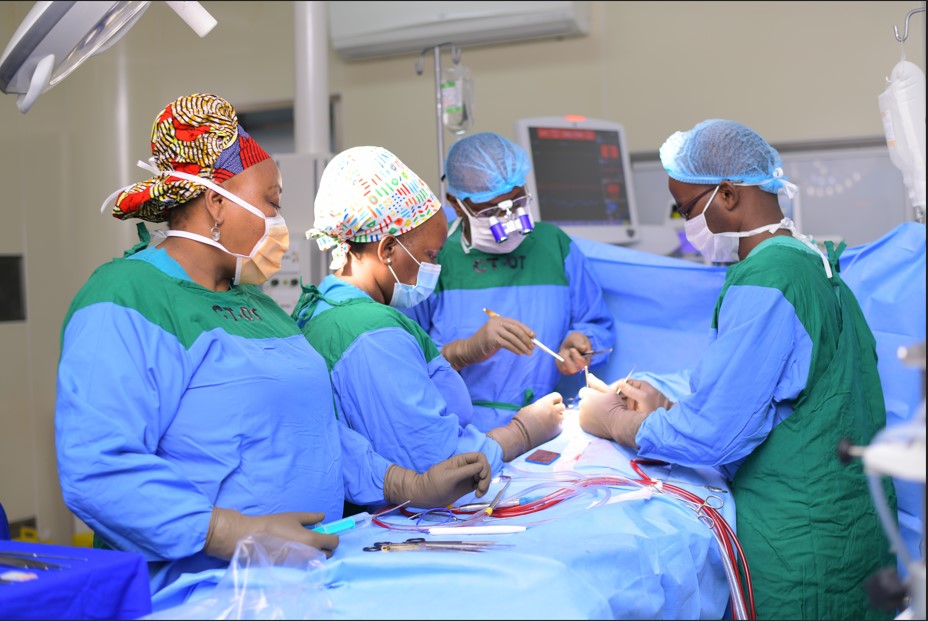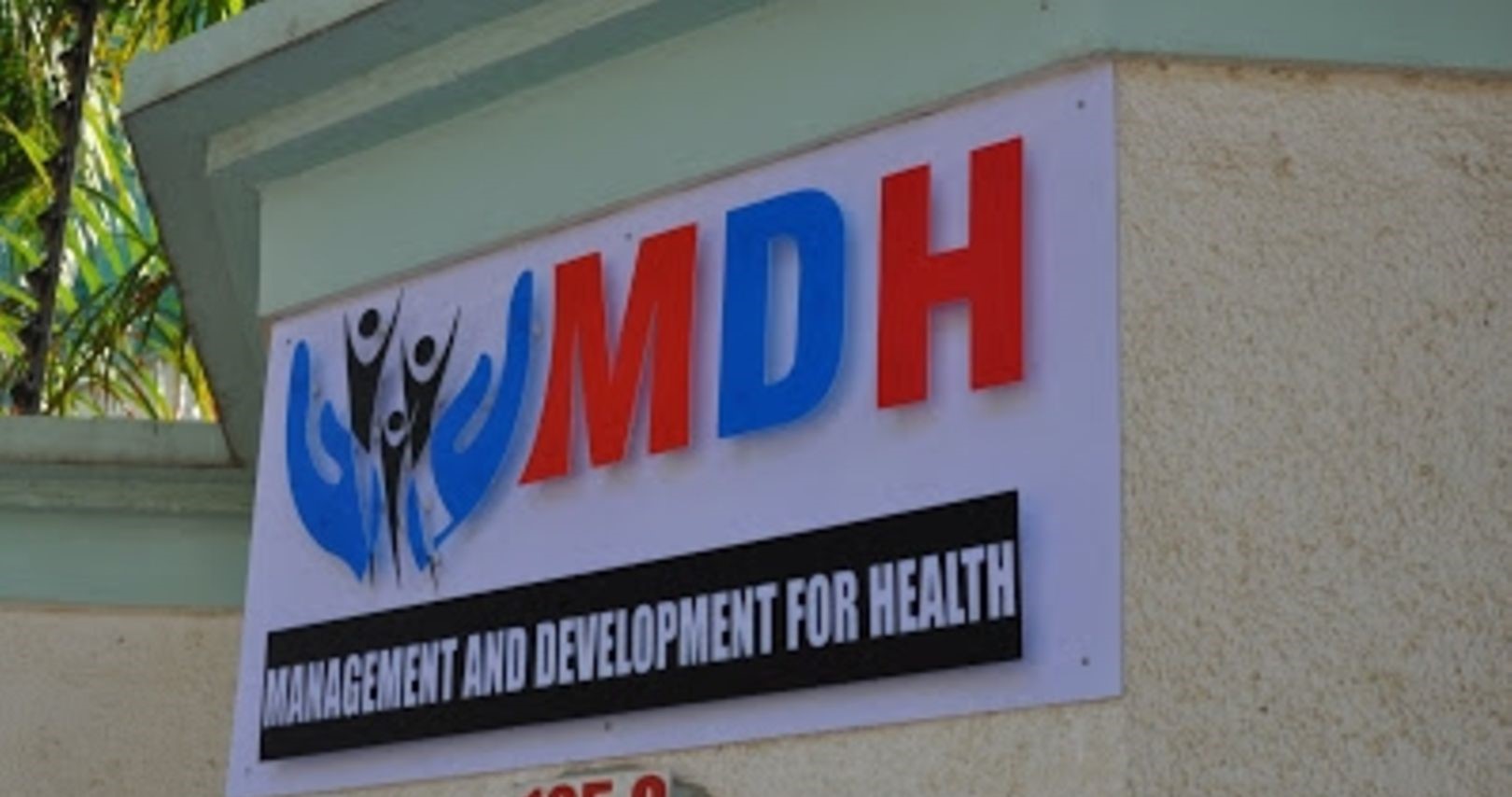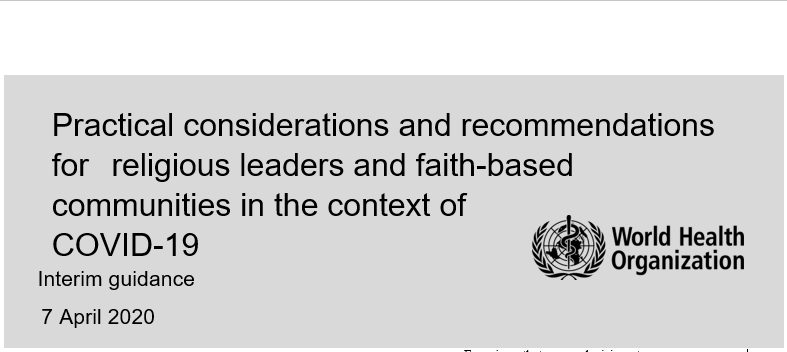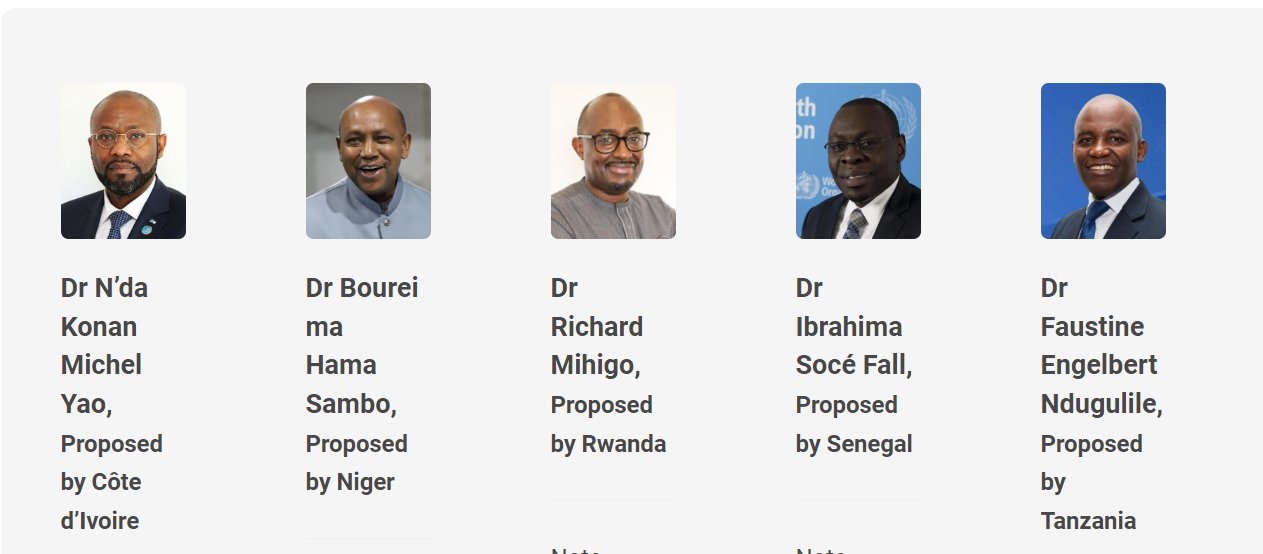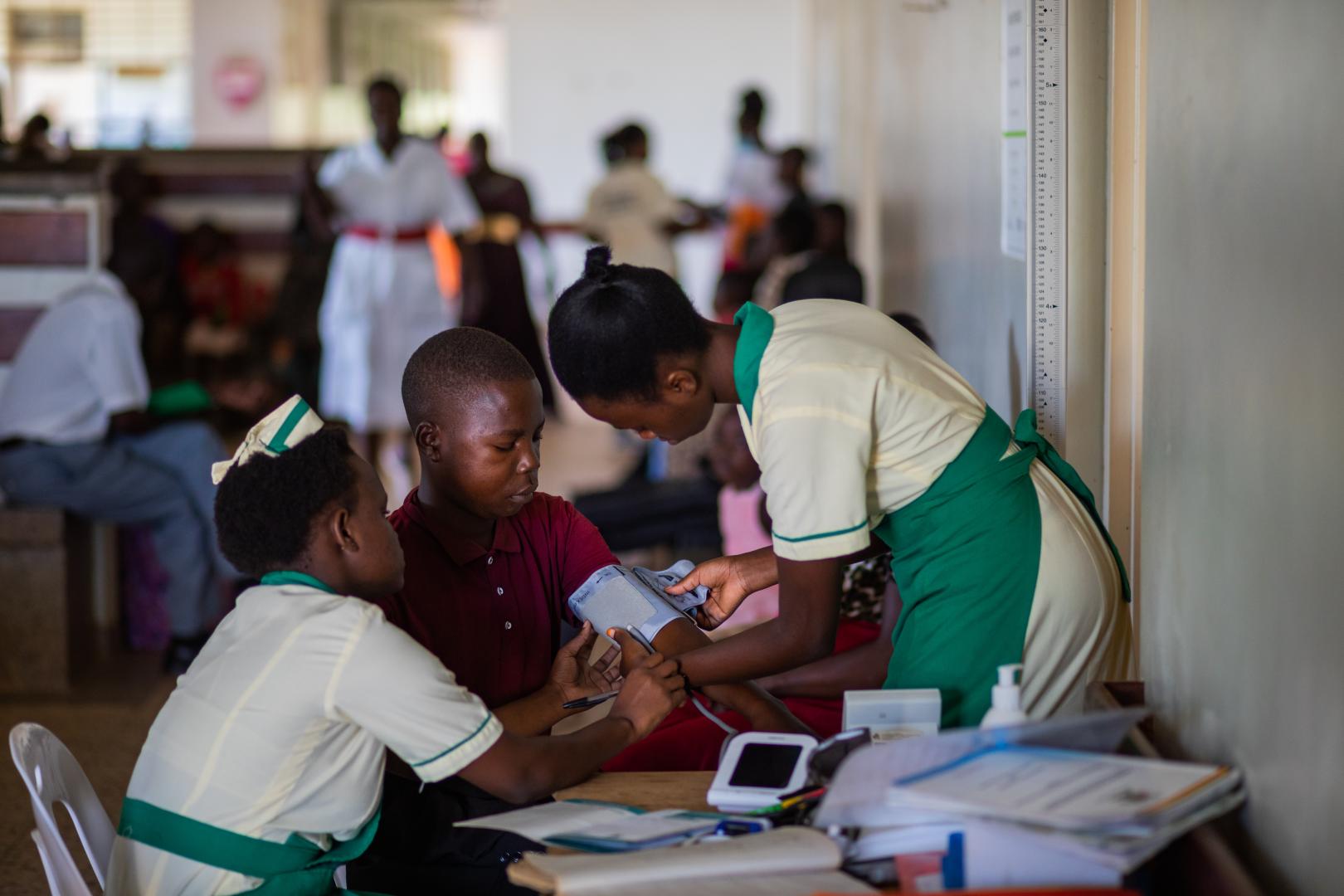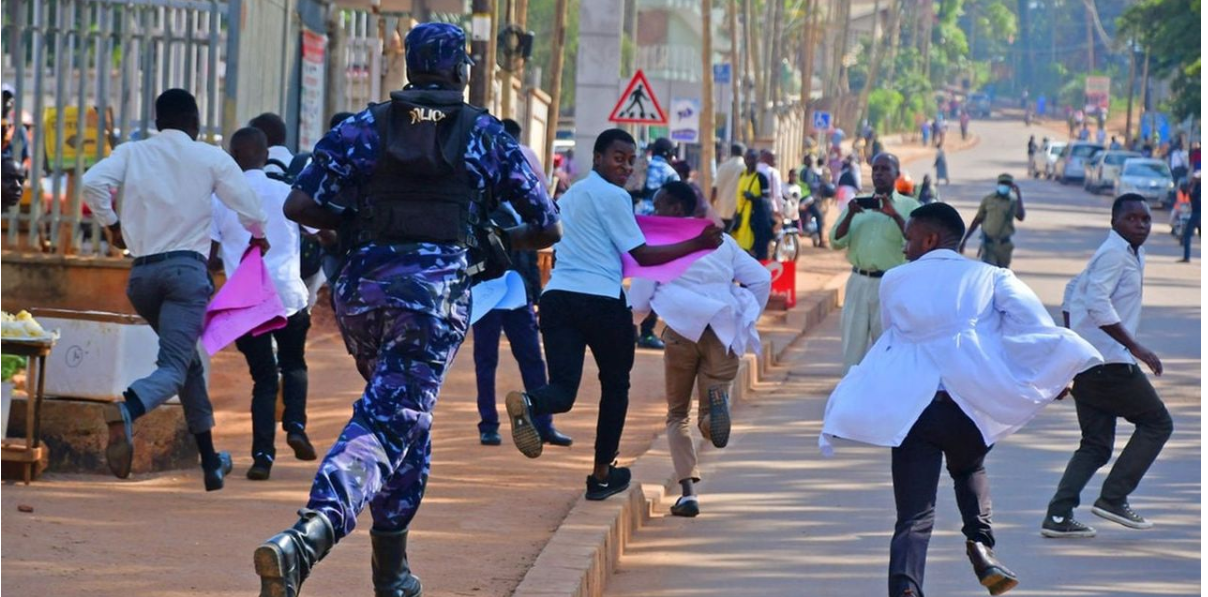Background
Religious leaders, faith-based organizations, and faith communities can play a major role in saving lives and reducing illness related to COVID-19.[1] They are a primary source of support, comfort, guidance, and direct health care and social service, for the communities they serve. Religious leaders of faith-based organizations and communities of faith can share health information to protect their own members and wider communities, which may be more likely to be accepted than from other sources. They can provide pastoral and spiritual support during public health emergencies and other health challenges and can advocate for the needs of vulnerable populations.
By sharing clear, evidence-based steps to prevent COVID-19, religious-inspired institutions can promote helpful information, prevent and reduce fear and stigma, provide reassurance to people in their communities, and promote health-saving practices. Religious leaders are integrated into their communities through service and compassionate networks and are often able to reach the most vulnerable with assistance and health information and identify those most in need. Religious leaders are a critical link in the safety net for vulnerable people within their faith community and wider communities.
Purpose of this guidance
This document is based on guidance and recommendations developed by WHO in response to the COVID-19 pandemic. It acknowledges the special role of religious leaders, faith-based organizations, and faith communities in COVID-19 education, preparedness, and response, through:
- Sharing evidence-based information about COVID19, preparedness, and response
- Avoiding large group gatherings and conducting rituals and faith-related activities remotely/virtually, as required and whenever possible
- Ensuring that any decision to convene group gatherings for worship, education, or social meetings is based on a sound risk assessment and in line with guidance from national and local authorities
- Ensuring safe faith-based gatherings, ceremonies, and rituals when they do occur
- Strengthening mental and spiritual health, wellbeing and resilience, through individual contact (while observing appropriate physical distancing) and through social and other communications media
- Ensuring that a human-rights-based approach to advocacy, messaging, and service delivery is systematically upheld
- Addressing stigma, violence, and the incitement of hate
- Promoting ecumenical and interfaith collaboration, and peaceful coexistence during the COVID-19 pandemic
- Ensure that accurate information is shared with communities; counter and address misinformation.
Gatherings (where permitted)
Local and national health authorities are the primary source of information and advice about COVID-19 in communities and can provide information about locally mandated restrictions on the movement of people, whether gatherings are permitted and, if so, of what size. Those organizing a gathering should comply with guidance issued by national and local authorities and if a medium or large gathering is planned, the organizers should establish and maintain contact with the authorities in the buildup to and for the duration of the gathering. If gatherings are permitted, religious leaders and faith-based communities should take the following steps to reduce the threat of COVID-19 in their community.[2] If they are not able to perform these steps to keep their community safe, then the planned physical gatherings should be cancelled. Once decisions have been made, it may be helpful to describe any adjusted practices and measures and visibly present them at the entry of the place of gathering (in writing or drawing).If remote/virtual gatherings are not feasible, keep the duration of the gathering to a minimum to limit contact among participants.
Maintain at least 1 m (3 feet) of distance between people at all times

Discourage non-essential physical gatherings and organize virtual gatherings through live-streaming, television, radio, social media, etc.COVID-19 is spread through respiratory droplets when an infected person sneezes, coughs, or talks. These droplets can land on people or be breathed in by those close by. Religious institutions and faith-based organizations should protect their members by helping them maintain a safe distance between them (“physical distancing”).
- If a gathering is planned, consider holding it outdoors. If this is not possible, ensure that the indoor venue has adequate ventilation.
- Regulate the number and flow of people entering, attending, and departing from worship spaces to ensure safe distancing at all times.
- Gatherings with few people are better than crowded sessions. Religious leaders and communities of faith should consider multiple services with a few attendees, rather than hosting large gatherings.
- The numbers and flow of pilgrims at pilgrim sites should be managed to respect physical distancing.
- Seating or standing of participants in faith services should be at least 1 m (3 feet) apart. Where necessary, create and assign fixed seating to maintain safe distances.
- Identify a room or area where a person could be isolated if he or she becomes ill or begins to develop symptoms.
Prevent touching between people attending faith services
Many faith traditions involve physical contact between worshippers. Respiratory droplets containing COVID-19 can settle on a person’s hands and can be passed on to others through physical contact. Religious leaders and faith-based communities should consider how worship practices and community connections can be adapted to prevent touching between participants in services and other faith- or community-based activities.
Create new ways for your community to greet one another that reduce the risk of COVID-19 transmission. Some greetings being adopted within faith communities include:
- Replace hugs, kisses, and handshakes with a bow or peace sign or using a greeting in sign language while maintaining physical distance.
- Greet people at the entry to worship spaces with friendly words and smiles, rather than handshakes or other forms of physical contact.
Many worshippers share a “sign of peace” during services including handshakes and hugs. These are being replaced by, for example:
- Eye contact and a bow while saying “the peace” to others.
- A communal “sign of peace” offered in unison, orally, or through a bow, by the attendees in unison, while staying in place at a safe distance between each other.
- Any form of culturally and religiously sanctioned alternative that avoids physical contact.
Prevent touching or kissing of devotional and other objects that the community is accustomed to handling communally
Many faith traditions include touching or kissing of sacred and symbolic objects during worship services and prayer. The virus that causes COVID-19 can remain on such surfaces for hours or days. Religious leaders and faith-based communities need to protect their members from becoming infected by avoiding practices involving touching or kissing of such surfaces. Leaders can create and help community members accept new ways to reverence these objects and symbols safely. Some religious leaders and faith communities have encouraged their members to:
- Bow before sacred statues or icons, instead of touching them.
- Receive a blessing from at least 1 m away and avoid the distribution of Holy Communion that involves placing the wafer on the tongue or drinking from a common cup.
- Consider using individual pre-packaged boxes/servings of religious or ceremonial foods, rather than shared portions from communal containers.
- Empty fonts of holy water to prevent people from dipping their fingers into a common bowl.
- Eliminate rituals involving touching such as foot washing and substitute appropriate practices.
- Encourage worshippers to perform their ritual ablutions at home before attending the place of worship.
Encourage healthy hygiene among participants in faith services and other activities when gatherings are permitted
- Help attendees maintain healthy hygiene practices by providing handwashing facilities for members before and after the service; feet washing facilities for places where worshippers enter barefoot; or by placing alcohol-based hand-rub (at least 70% alcohol) at the entrance and in the worship space.
- Place disposable facial tissues within easy reach and closed bins for used tissues.
- Ask worshipers to bring their own personal prayer rugs to place over the carpet for daily prayers.
- Encourage worshippers to avoid attending worship services if they have any symptoms of COVID-19 or if they have travelled recently to an area with community spread of COVID-19.
- When attendees enter a site or building barefoot, shoes and sandals should be placed separately and in bags.
- Provide visual displays of advice on physical distancing, hand hygiene, and respiratory etiquette.
Frequently clean worship spaces, sites, and buildings
- Establish routine cleaning with disinfectant of worship spaces, pilgrimage sites, and other buildings where people gather, to remove any virus from the surfaces. This routine should include cleaning immediately before and immediately after all gatherings.
- Frequently clean often-touched objects such as door knobs, light switches, and stair railings with disinfectant.
- Conducting faith activities remotely/virtually (as long as required)
It is likely that most religious leaders and communities of faith will make decisions to cancel services and other gatherings for some time in the COVID-19 pandemic. Large gatherings are already banned or are being discouraged in many countries. Religious leaders should remember that they are important community role models for reinforcing these recommendations and showing how communities can still maintain connection by conducting faith activities remotely/virtually. The suggestions below are already being used by many religious leaders to maintain connection with and among their members through high and low technological means. Where online technologies are used, religious leaders can provide information on the potential cybersecurity risks, particularly where children and vulnerable adults are concerned.
Use technology to maintain community and continue worship
Consider how your faith community or organization can use technology to make services and other faith-based events available online. Consider partnering with other organizations to leverage on-line channels. For example:
- Video or audio-tape worship services and ceremonies and broadcast or post them on social media.
- Conduct individual pastoral and care visits by phone or through social media and video chat platforms.
- Use a remote or virtual meeting platform or teleconference facilities for meetings or small group interactive prayer.
- Expand use of television and radio channels.
Use low-technology means to maintain faith-based practices in the community
Not every faith-based organization has the capacity to engage its members using advanced technology. Even so, the community can continue to connect through practices such as:
- Telephone calls between members of the faith community for paired-prayer and use of telephone “chat” services.
- Communicating times when your faith community can observe religious practice remotely (prayer, specific liturgies, etc.) at the same time every day or week, despite being physically apart.
- Encouraging individual and household observance of prayer and other spiritual practices.
- Compiling and circulating requests for prayers from the faith community to be supported by all members.
Safe ceremonies
Many celebrations and solemn ceremonies performed by religious leaders in worship spaces will need to be modified during the COVID-19 pandemic.
- Where gatherings are allowed by local health authorities, religious leaders can perform ceremonies such as weddings and funerals if they follow the guidance for physical distancing as outlined in the “Safe Gatherings” section of this document and by observing the limits set by national or local public health authorities on the number of persons who can participate in such gatherings.
- When in-person gatherings cannot be held in accord with national or local public health guidelines, ceremonies may still be possible with essential members in attendance and a larger number of guests participating through distance, live streaming, and video technologies.
- If/when health authorities issue guidance limiting inperson funeral prayers, extended family members and friends can offer funeral prayers in absentia.
Safe burial practices
Faith leaders can help grieving families to ensure that their departed loved ones receive respectful, appropriate funerals and burial rites, even in the midst of the COVID-19 pandemic. Knowing how to safely plan and perform such funeral rituals and services worship can both protect and comfort mourners and show respect for those who have died without causing any infectious risk to the mourners.
- When acceptable or appropriate according to respective faith traditions, embalming, burial, and cremation should be allowed for the remains of persons who have died of COVID-19.
- Religious leaders and local religious communities can work with families to integrate appropriate religious and cultural practices with burial and funeral steps that reduce the chances of infection. For example:
- If washing the body or shrouding are part of faith traditions, modifications will be needed to protect mourners:
- At a minimum, people conducting these activities should wear disposable gloves.
- If splashing of body fluids is possible, additional personal protective equipment may be required for those participating in the ritual (such as disposable gowns, face shields or goggles and medical masks).
- If the family of the deceased wishes to view the body after its removal from the medical facility where the family member has died, they may be allowed to do so, in accordance with local physical distancing restriction, with no touching or kissing of the body and thorough handwashing before and after viewing.
- As modifications to burial and funeral rites are adopted, particular attention should be paid to protect children and older adults in attendance.
Strengthening mental health and resilience
Religious leaders and faith communities play a unique role in creating relationships and connections between people across age groups, professions, and neighborhoods. In addition, religious leaders are often linked into other service organizations through their professional and pastoral roles. As a result, these leaders and organizations are uniquely positioned to reinforce connections between people who may be isolated during periods of physical distancing. Maintaining and strengthening relationships during this distressing time can fortify the mental and spiritual health of your members and followers and contribute to resilience in the larger community. Religious leaders can also help their communities respond to COVID-19 with practices appropriate to their organization’s mission or faith tradition. Practices such as prayer, inspirational reading, and safe community service can build confidence and create a sense of calm. Below are steps that can help.
Keeping the community connected
Religious leaders and faith-based organizations can strengthen their communities and combat self-isolation through regularly checking in on individual members, preferably via phone. This is particularly important to account for individuals who may be living alone, who are elderly, who have disabilities or are otherwise vulnerable. They can ensure that community contact lists are up-to-date and accessible to their members. Organizations can create “calling trees” in which individual members volunteer to phone several other members regularly to check on their well-being. In-person visits should be avoided where possible and if necessary, should employ appropriate physical distancing and other preventive measures. Additionally, religious leaders are encouraged to prevent family separation and promote familybased care options in situations where children are separated from their families.
Helping others
Helping others who need assistance can benefit the person giving the assistance as well as the person receiving it. Faith communities can identify ways that their members can help others, depending upon individual risk levels (checking on the elderly, people with disabilities, and vulnerable neighbors by phone and offering to deliver groceries, etc.). Religious leaders and faith communities can promote the sharing of resources to provide for those whose livelihoods are disrupted and who cannot provide for themselves and their families. Of particular importance is the care for health workers, law enforcement officers, and workers in essential services who continue to work, sometime away from their families. Religious leaders can encourage those who have the financial means to make donations to those whose livelihoods have been affected by the pandemic. As community members work together, they can create a sense of solidarity and build resilience.
Helping members manage the onslaught of worrying news
Religious leaders can encourage their communities to take steps to manage their stress and to keep up hope during such times of isolation, fear, and uncertainty. The constant torrent of news reports about COVID-19 can cause anyone to feel worried. Religious leaders can encourage community members to seek information on the virus at a few, regular, select times a day, and point members to credible sources of information, and to maintain hope by reading sacred texts and guidance from their respective faith traditions.
Responding to situations of domestic violence
In settings where movement restrictions are in place, there is the potential for an increase in domestic violence, particularly against women, children, and other marginalized people. Existing vulnerabilities associated with age, religion, migration status, sexuality and ethnicity may be exacerbated. Religious leaders can actively speak out against violence and can provide support or encourage victims to seek help. Where a child is concerned, religious leaders should be informed of child protection and safeguarding policies, including what to report, to whom, and how.
Offer special prayers for the sick alongside messages of hope and comfort
Religious leaders can provide faith communities with appropriate prayers, theological and scriptural reflections, and messages of hope. Highlighting the opportunities presented for reflection, prayer, and time with family members others can prove helpful.
Faith leaders’ role in COVID-19 education
Religious leaders, faith-based organizations, and communities of faith are among the most trusted sources of information, as well as both pastoral, health, and social care in our communities. Their followers and community members may trust and follow guidance about COVID-19 coming from faith leaders even more than if delivered by governments and health authorities. The health care and social services of faith-based organizations are often more accessible, especially in rural communities and among marginalized populations. Faith leaders also have a special responsibility to counter and address misinformation, misleading teachings, and rumors, which can spread rapidly and cause great damage. Sermons and messages can build on factual information provided by WHO and national or local public health authorities and is in line with doctrine/teaching and practice of their respective faith traditions.
What to communicate
Accurate information can reduce fear and stigma. Religious leaders can access guidance in formats and lay language that their members can understand. WHO’s guidance has been replicated and shared on certain faith platforms. Religious leaders should also be aware of local and national health authorities websites and other information channels to access local guidance.
The most important protection information religious leaders and faith-based communities can communicate to their members includes the following:
- Avoid touching eyes, nose and mouth. Hands touch many surfaces and can pick up viruses. Once contaminated, hands can transfer the virus to your eyes, nose or mouth. From there, the virus can enter your body and can make you sick.
- Practice respiratory hygiene. The virus is spread through respiratory droplets. By following good respiratory hygiene, you protect the people around you from viruses such as flu and COVID-19. This means covering your mouth and nose with your bent elbow or tissue when you cough or sneeze. Then dispose of the used tissue immediately in a bin with a lid and wash your hands.
- Stay home if you feel unwell. If you have fever, cough and difficulty breathing, seek medical care and call in advance. Calling in advance will allow your health care provider to quickly direct you to the right health facility. This will also protect you and help prevent spread of viruses and other infections.
- Regularly and thoroughly clean your hands with an alcohol-based hand rub or wash them with soap and water. Washing your hands with soap and water or using alcohol-based hand rub kills viruses that may be on your hands.
- Maintain at least 1 m (3 feet) distance between yourself and anyone who is coughing or sneezing. A person who coughs or sneezes sprays small liquid droplets from their nose or mouth, which may contain virus. If you are too close, you can breathe in the droplets, including the COVID-19 virus if the person coughing has the disease.
- Follow the instructions of your local health authority. National and local authorities will have the most current information on the situation in your area. They are best placed to advise on what people in your area should be doing to protect themselves.
- Stay informed and follow advice given by your health care provider, your national and local public health authorities or your employer on how to protect yourself and others from COVID-19. Stay informed on the latest developments about COVID19 from WHO and national authorities.
- Stay informed about risk; older people and people with underlying medical conditions are more at risk of severe illness.
How to communicate health protection information
Faith leaders are encouraged to use faith channels such as organizational web pages; newsletters; emails; phone tree; and faith publications, radio, or other broadcast media. Social media technologies offer religious leaders, faith-based organizations, and communities of faith new ways to share life-saving messages. COVID-19 messages can also be woven into sermons and prayers to be shared with communities. It will be important for community members to hear these messages and updates frequently on different channels and message platforms.
Because of their influence, religious leaders can be powerful resources for agencies and organizations that are communicating with the public about COVID-19. Leaders should become informed on organizations presenting credible information in their communities and join with them, using and endorsing their messages (e.g. WHO, universities, nongovernmental organizations).
Upholding human rights and addressing stigma and discrimination
Religious leaders have a particularly important role to play in championing attention to and inclusion of, vulnerable populations including minorities, migrants, refugees, internally displaced persons, indigenous peoples, prisons, people with disabilities, and members of other marginalized groups, by creating supportive environments; advocating for their rights and access to diagnosis, treatment. and vaccines; sharing evidence-based accurate information; and publicly standing against statements and acts that encourage violence and human rights violations against people. By drawing on language within their own faith tradition, religious leaders can promote positive messages that affirm the dignity of all people, the need to protect and care of the vulnerable, and inspire hope and resilience in those affected by, or vulnerable to, COVID-19. On the practical side, faith-based organizations can work with health and development agencies to identify mechanisms to increase access to information and services for vulnerable communities, including those that are provided by faith-based organizations themselves. Moreover, most of these faith traditions serve all people in need, without regard to national or ethnic origin, race, sex, or religious affiliation, and are motivated by universal values and ethical principles of “do no harm,” solidarity”, and the “golden rule”.
Conclusion
Various global religious and inter-religious groups have issued guidance, advisory notes, and statements to support the actions and role of religious leaders, faith-based organizations. and faith communities during the COVID-19 pandemic. Many of those same groups have contributed to this guidance, through a common acknowledgement that COVID-19 is a global pandemic, affecting all races, ethnicities, and geographic regions, that demands a global response. Interfaith collaboration between both majority and minority faiths is crucial, particularly through the sharing of knowledge, resources, and best practices where possible.
The accompanying decision tree provides a simple flow chart to support decision-making regarding hosting a religious event during the COVID-19 pandemic. When national or local authorities permit gatherings, the organizers of a gathering can make their own informed decision about the risk and plan appropriately based on it.
WHO continues to monitor the situation closely for any changes that may affect this interim guidance. Should any factors change, WHO will issue a further update. Otherwise, this interim guidance document will expire 2 years after the date of publication.
[1] For terminology descriptions please refer to http://data.unaids.org/pub/report/2010/jc1786_fbo_en.pdf
[2] These steps are based on Key planning recommendations for Mass Gatherings during COVID-19

